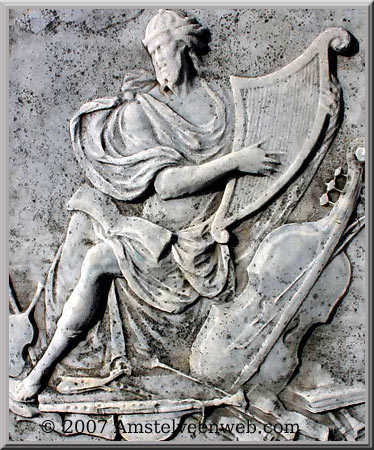Begraafplaats Beth Haim op de 2012 World Monuments Watch
Nieuws -> OuderkerkBron: Beth Haim / Géke Beek
06-10-2011
Op 5 oktober 2011 is door het World Monuments Fund in New York officieel bekendgemaakt, dat de Portugees-Israëlietische begraafplaats Beth Haim in Ouderkerk aan de Amstel als wereldmonument is geselecteerd voor de World Monuments Watch 2012.
Met het programma van het WMF worden iedere twee jaar locaties over de hele wereld geselecteerd die om natuurlijke, politieke, sociale of economische redenen in hun voortbestaan worden bedreigd. Wij hopen, dat deze erkenning ons zal helpen fondsen te vinden voor onderhoud en restauratie om dit belangrijke cultureel erfgoed voor de toekomstige generatie te bewaren.

(Foto Amstelveenweb.com - 2007)
Een poetische gravure op een marmeren zerk op de begraafplaats Beth Haim
Beth Haim ‘Huis des Levens’ in Ouderkerk aan de Amstel is 4 ha groot en dateert uit 1614. De begraafplaats is open voor publiek. In bijna 400 jaar is de begraafplaats met ca. 28.000 graven in oorspronkelijke staat gebleven. Er is dringend geld nodig voor behoud van de monumentale zerken en restauratie op de grafvelden uit de 2e helft van de 19e eeuw, jaarlijks deskundig en intensief onderhoud. Vanaf 2012 vallen alle subsidies weg en is Beth Haim afhankelijk van giften.
Bestuur: David Henriques van het Castrofonds en Jacques Coronel, voorzitter
Voor meer informatie over Beth Haim: www.bethhaim.nl of bethhaim@gmail.com
Beth Haim has been selected for inclusion on the 2012 WORLD MONUMENTS WATCH
On October 5th 2011, it is officially announced that Beth Haim Portuguese Jewish Cemetery has been selected for inclusion on the 2012 WORLD MONUMENTS WATCH.
The watch is intended to call international intention to the challenges facing cultural heritage sites around the world. We hope that inclusion will have a positive effect on our site and will help us to protect this important cultural resource for future generations.
Making the past part of a better future
Every two years since 1996, the World Monuments Watch calls international attention to cultural heritage around the globe that is at risk from the forces of nature and the impact of social, political, and economic change.
The 2012 Watch
From the famous (Lines and Geoglyphs of Nasca, Peru) and little-known (Cour Royale at Tiébélé, Burkina Faso), to the urban (Charleston, South Carolina) and rural (floating fishing villages of Hạ Long Bay, Vietnam), the 2012 Watch tells compelling stories of human aspiration, imagination, and adaptation.









